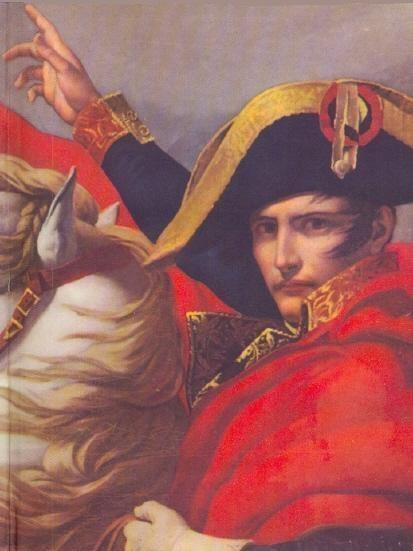
Edward Winter

What is known about Napoleon Bonaparte’s connection with chess? Despite frequent assertions that they are all spurious, three games allegedly played by him (i.e. against Bertrand, Mme de Rémusat and the Automaton) are regularly seen, not only in articles and books but also in databases (such as Essentia, which makes the improbable claim that the second of these was played in Paris in 1902).
A useful starting-point for the present overview of the Napoleonic chess connection is H.J.R. Murray’s A History of Chess (1913), which dismissed the matter in a one-paragraph footnote (page 877):
‘Napoleon was a persistent but a very weak player. Three games purporting to be played by him are in existence. One of these (a Scotch Game) said to have been played in St Helena between Napoleon and Bertrand, and first printed in Capt. Kennedy’s Reminiscences in the Life of Aug. Fitzsnob (Waifs and Strays, 1862), is certainly fictitious. The second game, said to have been played with Mme von Rémusat, 29 March 1804, and a third game (I.L.N., 1844, 352), played against the Automaton in Vienna, are also of very doubtful authenticity.’ [Regarding the Illustrated London News column on page 352 of the 30 November 1844 issue, see below our addition dated 23 May 2025.]
In contrast, on page 79 of A Short History of Chess (written in 1917 but not published until 1963) Murray wrote that Johann Allgaier ‘was the conductor of the Automaton when it played and defeated Napoleon’.
The Bertrand game was given on pages 120-121 of James Mason’s 1900 book Social Chess with this concluding comment:
‘A brilliant ending. This game has been recorded as one of many played by Napoleon v Marshal Bertrand, at St Helena, in or about 1820 … The Great Captain was also a great lover of chess, and practiced it, always on occasion, from his early youth to the last days of his life.’
When Social Chess was noticed by the BCM (pages 53-56 of the February 1900 issue) the unnamed reviewer wrote that the Bertrand game …
‘… is said to have been won by Napoleon Bonaparte of Count Bertrand, at St Helena, in 1820. The authority – the sole authority we believe – for this ascription is a semi-fictional sketch, entitled “Some reminiscences in the life of Augustus Fitzsnob, Esq.” by the late Captain Kennedy. This will be found reprinted in Waifs and Strays, the second edition of which does not give the date and place of first appearance of the sketch, but a footnote indicates that this must have been the American Chess Monthly, in which case the date cannot have been earlier than 1857 [July, 1860, in fact]. The game is not to be found in Walker’s Chess Studies, published in 1844, which affords reasonable ground for presumption that it was not then extant. It is supposed to have been shown by Count Bertrand to a Captain Lacy (stationed at St Helena), who afterwards took it down from memory, and allowed Lieut. Fitzsnob to take a copy of it, this last being on his way home, on furlough, from Calcutta, in a ship which calls at St Helena. Capt. Kennedy’s sketch may be partly autobiographical; the recollections of the Divan and other resorts suggest as much; but if so, is it credible that an author whose chess sketches found acceptance with the Chess Player’s Chronicle in the early forties would have kept on hand unpublished for 37 years a game which possessed such striking claims upon the interest of chess players? Moreover when Capt. Kennedy died in 1878, his age was reported as 68, which could make him only ten years old in 1820 – a fact which conclusively disposes of the autobiographical hypothesis in respect of Lieut. Fitzsnob’s voyage home in that year; and so vanishes Capt. Kennedy’s personal voucher for the authenticity of the game. The elusive personality of Lieut. Fitzsnob is hardly an authority on a question of fact, even if we could rest here; but there is yet another contradiction. When Mr Fitzsnob first went out to India as a cadet at the age of 16, the correspondence match between Madras and Hyderabad had, he tells us, just been commenced; the Madras side was conducted by Ghulam Kassim and the late Mr Cochrane, the latter of whom was still in England in the early part of 1824, since he took part in the earlier deliberations on the London-Edinburgh correspondence match, commenced in that year; therefore the Madras-Hyderabad match cannot be of earlier date than 1825 or 1826; and Lieut. Fitzsnob’s voyage home on furlough in 1820 is an anachronism. To conclude, the game may very well have been actually played – by someone; but we suspect that the military rank of the winner was considerably below that of a general officer.’
[Addition on 29 November 2010: Regarding the above quotation Tony Gillam (Nottingham, England) writes:
‘There is confusion between James Cochrane and John Cochrane. The Madras-Hyderabad match of the 1820s was the subject of a booklet by Ghulam Kassim and James Cochrane published in Madras in 1829. Those two players constituted the Madras “team”, with Ghulam Kassim taking the lead. James Cochrane worked for the Indian Colonial Service in an administrative capacity and died in Cheltenham in August 1830. He was on leave from his post in Madras. John Cochrane was initially in Bombay and later, for most of his Indian career, was a barrister in Calcutta.’]
Interest in Napoleon’s chess connections was pursued by Lasker’s Chess Magazine. Under the heading ‘Napoleon at Chess’, pages 222-223 of the September 1905 issue turned to the game against the Automaton with a quote from the St Paul Dispatch:
‘A correspondent of the New York Sun revives the following entertaining story concerning Napoleon and his ability as a chessplayer, which was published in the New York Chess Monthly during the fifties:
“When Napoleon entered Berlin, in 1806, somebody thought of the neglected Turk, and Mr Maelzel, a clever mechanic, was ordered to in pest [sic – presumably inspect] and repair the dusty old enigma. From cobwebbed dreams of King Fritz and the brave Empress, the veteran chess player awakened to encounter a greater man, fresh from the field of recent victories. On this remarkable meeting we may dwell for a moment, since its history has been faithfully preserved by an eye witness and has never before met the public view.
The emperor, on this occasion, signified his wish to do battle with the Turk, and accordingly Maelzel arranged a second table, near that of the Turk, proposing to repeat the moves on both tables. This was Maelzel’s usual mode of exhibition. Napoleon, characteristically overstepping the barrier which separated the Turk from the audience, struck his hand on the automaton’s chessboard and exclaimed, ‘I will not contend at a distance! We fight face to face.’ A grave nod indicated the Turk’s assent, and the game began. The emperor was disastrously vanquished. Shortly afterward a second exhibition was ordered. On this memorable occasion the emperor placed a large magnet on the automaton’s board. Maelzel smilingly moved the iron, so as not to embarrass the game. The Turk played on with his usual skill; the fatal échec (check) was heard again and again, and a second time Napoleon was defeated.
The pieces were no sooner arranged than the emperor quietly removed a shawl from the shoulders of a lady near by, and with great care enveloped the face, the neck and the body of the Turk, completing his arrangements with an exclamation of satisfaction. With a muffled nod the Moslem agreed to the new conditions and this third time also victory declared itself for the Turk. For a moment the emperor regarded his antagonist, then, with a gesture of scorn, he swept the chessmen from the board, and crying: ‘Bagatelle!’ strode over knight and pawn and so out of the room.”’
On page 326 of The Chess Amateur, August 1907, the chess historian W.S. Branch made a poor effort to summarize the state of knowledge:
‘Napoleon I was never a strong player and had very little, if any, book knowledge; he played many games in Paris, some at the Café de la Régence – while a young artillery officer; others while an exile in St Helena. Three weakly played games are extant which are said to have been won by Napoleon. All are doubtful, especially one. For the other two I know of no respectable authority besides the late Capt. Kennedy, of Bath, who said he had them from a French officer who played with Napoleon. Possibly these two are genuine, but we cannot be sure of it. None appeared in print till 1850.’
In the mid-1920s a detailed article about Napoleon and chess, largely based on material from Le Palamède, was published on pages 129-136 of the fifth issue of François Le Lionnais’ magazine Les Cahiers de l’Echiquier Français. Below is a summary.
Throughout his life Napoleon had a deep love for chess, but was not a player of the first rank. He did not have time to study the game in depth; he opened poorly; he gave many signs of impatience if his opponent took too long over a move. However, he would sometimes liven up and play fine moves.
According to Labourdonnais, when Napoleon was preparing for his Polish campaign he was playing chess one evening with Marshal Berthier in the Tuileries Palace when it was announced that the Persian ambassador desired an audience. Since Napoleon continued to play chess, the ambassador gained his (partial) attention by claiming that the Persian cavalry was the best in the world. Responding to this, Napoleon, still engaged in his chess game, wrote out orders for his own cavalry (40,000 men) to go on parade at the Tuileries the following morning. The colourful George Walker (Frazer’s Magazine, December 1840) is given as the source for this story.
In Egypt Napoleon played with M. Poussielgue, and M. Amédée Jaubert. During the Polish campaign, his opponents were Murat, Bourrienne, Berthier and the Duke of Bassano. The last-named often played with Napoleon and he wrote: ‘The emperor was not skilful in opening a game of chess. From the outset he often lost pieces and pawns, but his opponents did not dare take advantage thereof. It was only in the middle-game that he was inspired; the mêlée of pieces kindled his intelligence; he saw more than three or four moves and implemented beautiful and clever combinations’. At St Helena he played every day. ‘If the game of chess had not already attained high nobility, it would be ennobled by giving a few moments of happy diversion to the greatest of prisoners and exiles’ (Le Palamède, 1836, pages 12-13).
During his captivity at St Helena Napoleon received from the Governor of the Indies, Sir John Elphinstone, a superb chessboard made by the best Chinese workmen. Napoleon had been generous to an English officer named Elphinstone, and when the captain’s brother, Sir John Elphinstone, learned that Napoleon’s sole pastime at St Helena was chess he had the set made. The letter N, surmounted by the Imperial Crown, was engraved on each piece. It was decided by Hudson Lowe that the chess set would be given to Napoleon only if he agreed to have the N and the imperial crown effaced. On learning this, Napoleon shrugged his shoulders and said to Marshal Bertrand: ‘Is the despatch of this chessboard an affair of state? Does this man fear that I shall give check to all the kings of Europe? Poor man.’ Napoleon was more impressed by the generous gesture than by the cumbersome chess set itself. The rook sat on an enormous elephant, and Napoleon said jokingly, ‘I should need a crane to move this rook. I shall send the basket to Marie-Louise, the box of counters to my mother and the chess pieces to my son’. (Le Palamède, 1839, pages 14-22)
The Mémorial de Sainte-Hélène by Napoleon’s companion in captivity, the Comte de Las-Cases, stated (December 1815), ‘Before dinner, the emperor always played several games of chess. After dinner, we reverted to playing reversi …’ In the August 1815 issue, the Comte had written of a voyage on the Northumberland: ‘After piquet there were several games of chess with the great Marshal, M. de Montholon, or another, which led up to dinner. Nobody on the ship was very strong; the Emperor was exceedingly little so. He defeated some and lost to others, which led him to say one evening, “How is it that I lose very often to those who have never defeated the one whom I almost always defeat? Is there not a contradiction there? How is this problem to be resolved?”, he said, winking, to show that he was not taken in by the customary gallantry of one who was, in fact, the strongest.’
In Mémoires XXV the Duchesse d’Abrantès wrote:
‘On one occasion the First Consul was playing chess; as he was not very strong, he used the same method as in reversi. The game could never finish because there were always two white bishops or two black bishops. He did not like this to be remarked upon too seriously. He was the very first to laugh about it. But he was evidently angry that we accorded it too much importance.’
The game against Madame de Rémusat was said to have been played at Malmaison on the day that the Duc d’Enghien was executed, and it was published in Le Palamède in July 1845, pages 328-330. From Histoire du Consulat et de l’Empire, IV, pages 603-604 by Thiers, regarding the scene at Malmaison on 20 March 1804:
‘The First Consul had arrived in search of rest and isolation at his retreat at Malmaison. Those in attendance that evening were his secretary, Josephine, a few ladies and a few officers.
Alone, inattentive, feigning calm, he finally sat down at a table and played chess with one of the most distinguished ladies in the consular court, who, knowing that the Prince had arrived, trembled with dread at the possible consequences of that fateful day. She did not dare lift her gaze to the First Consul, who absent-mindedly murmured several times the best-known verses of our poets about clemency – first the lines Corneille gave to Auguste and then those from Voltaire to Alzire.’
This gave the lady hope that the Duke might be saved.
Le Palamède (July 1845, pages 328-340) reported that it was Mme de Rémusat who played against Napoleon that evening. The following morning the Duc d’Enghien was shot. Josephine wept on learning the news, and Mme de Rémusat did not think of asking Napoleon for a return game.
Les Cahiers de l’Echiquier Français went on to say that the game against the Automaton was played in 1809 at Schönbrunn Castle, which was occupied by Napoleon during the Wagram campaign, and the French magazine’s article concluded dryly: ‘The three games played by the Emperor leave no wish to have others.’
A steady stream of Napoleon articles appeared in chess magazines. On page 67 of the February 1929 BCM ‘B.J.B’ wrote:
‘The Napoleon-Bertrand game is not authentic. It comes from chapter iii of Some Reminiscences of Augustus Fitz Snob Esq., in Captain H. Kennedy’s Waifs and Strays (first edition, 1862, page 46; second edition, enlarged, 1876, page 37). It was a mere temporary mystification, and Kennedy afterwards admitted that the game was really won by himself from the Rev. John Owen.’
Ten years later the BCM returned to the subject, following the publication of Chessmen by Donald M. Liddell. On pages 5-7 of the January 1939 issue John Keeble noted that Liddell’s book relied on Kennedy’s Waifs and Strays, quoting the following passage from Kennedy:
‘“That’s well over”, said my companion (Captain Norris the orderly officer for the time being), “for today at least I shall have some peace and not be kept on the tramp for hours, or obliged to hang about doors like a footman. Did you observe the chessmen he was playing with? They are a magnificent Chinese set of exquisitely carved ivory, marked with eagles and the initial N surmounted by the Imperial Crown. They were sent here by the Honourable John Elphinstone, as a token of gratitude to Bonaparte for having saved the life of his brother, Captain Elphinstone of the 15th Light Dragoons. He was severely wounded and made prisoner the day before the battle of Waterloo.”’
Keeble reported that Liddle had been trying to find the above-mentioned set of men and had therefore contacted the then Baron Elphinstone, Carberry Tower, Scotland, receiving the following reply:
‘I enclose copy of the note in the catalogue made here by my father about 60 or 70 years ago. “Napoleon having been civil to Captain J.D. Elphinstone, of the 7th Hussars, when wounded at Quatre Bras and taken prisoner, the Hon. Mrs Elphinstone, his mother, wrote to her son John, then chief of the Factories (of the East Indian Company) at Canton, to make a point of visiting the Emperor at St Helena when he returned from China. John was there on Napoleon’s day when it was customary to make small presents. He gave the Emperor some Chinese silk shawls, and learned that the Emperor was anxious for a set of chessmen. Having none on board, he sent orders to Canton for a set. On their arrival at St Helena, Sir Hudson Lowe, the Governor of the island, would not allow them to be delivered as the Kings were crowned with what he maintained was an Imperial Crown. The set was therefore returned to J.F. Elphinstone”.’
Keeble remarked that he had long regarded the relevant part of Kennedy’s book as more or less fictitious:
‘For one thing Kennedy wrote the tale in imitation of the Snob Papers by Wm. Makepeace Thackeray, published in Punch in 1847. Kennedy called his account “Some Reminiscences in the life of Augustus Fitzsnob, Esq”. He made three chapters of it. All the chess references to Napoleon are in the third of these and in that chapter Augustus is called Lieutenant Fitzsnob. Now a person writing under a heading like that is not bound down to speak the truth on all occasions. His aim would be to make his tale pointed and interesting, and he could with impunity, if it suited his purpose, alter a Chinese shawl into a set of chessmen, or even, to go with it, invent a new story that was entirely devoid of truth, and this is what did happen. In connection with the tale, Kennedy gave a brilliant game saying it was played by Napoleon against Count Bertrand. In relating details of this he mentioned that the game emanated from Count Bertrand, who once showed it to Captain Lacy as a game that Napoleon had won against him, and Lacy, he said, afterwards took it down from memory and allowed me to have a copy of it. Kennedy’s final note on this is good, “and as the game is very characteristic of the Emperor’s peculiar style of play I give it here”.’
Keeble continued:
‘On page 57 of his book, Mr Liddell inserts the whole of this game, quoting both Captain Kennedy and a Spanish source. He also, like Kennedy, said it was a game played by Napoleon against Count Bertrand, but, nearly 60 years ago, it was proved that Captain Kennedy played this brilliant game himself. It is one he played against Mr Owen of London. I do not now remember full particulars of the case, but I made a note in the Kennedy book which reads, “See Chess Player’s Chronicle, page 271, year 1880”. I think many people will agree that a tale like this throws considerable doubt upon other parts of the story, and I still question whether there ever was a set of Chinese chessmen. Even if there was it is extremely unlikely that Napoleon would have played with it. Delicately constructed and exquisitely carved Chinese sets of that day were made for show only. All this is somewhat unfortunate for Napoleon, whose fame as a good chessplayer almost entirely depends upon what is said in these Fitzsnob Papers. Elsewhere he is generally referred to as a mediocre player.’
The article by Keeble gave rise to some correspondence from two readers on pages 110-112 of the March 1939 BCM. E. Alan Baker of London described Keeble’s article as ‘extraordinarily interesting’ and added the following information:
‘There is ample evidence that the chessmen from Mr Elphinstone did arrive at Longwood; also, if the Fitzsnob Papers are fictitious (most probable) there are other indications of Napoleon’s chess ability.
With regard to the present of the Chinese chess set from Mr Elphinstone, Napoleon did receive them, according to the following authorities: Gourgaud, Baron: St Helena Journal… 1815-18 (London, 1932); Young, Norwood: Napoleon in Exile, 1815-21 (2 v., London, 1915); Balmani, Count: Napoleon in Captivity: the Reports of Count Balmani, Russian Commissioner … 1816-20 (London, 1928); also Forsyth, W.: History of the Captivity of Napoleon at St Helena from the Letters and Journals of the late Lieut.-Gen. Sir Hudson Lowe (3 v., London, 1853).
Hudson Lowe did send them, but wrote a few days later saying that under his instructions he should have withheld them. This owing to the Imperial Crown and the N. England never recognized (before or after Waterloo) Napoleon the Emperor, but only General Bonaparte.
Napoleon was enraged at Lowe’s letter, and dictated to Bertrand a reply of which the following is an extract:
“Count Bertrand to Sir H. Lowe.
Longwood, 9 July 1817
Governor,
I have received the five cases which you took the trouble of sending me, containing a chess set and men, a box of counters, and two workbaskets in ivory, sent from Canton by Mr Elphinstone. The emperor was surprised to perceive by your letter that you think your duty required that these objects should not be sent. ‘If I acted’, you say, ‘in entire conformity to the established regulations, I ought to have delayed sending them up’. In this case, M. Governor, it would have been pleasing to us had you retained them …”
Lowe actually referred the matter to the British Government, and was ordered by Lord Bathurst (Foreign Secretary) to retain anything sent to General Bonaparte signifying any Imperial rank!!!
As for Napoleon’s ability at the game, there is other evidence to show he was a mediocre player. There was of course no reason why he should be anything else, except for the idea that a mind so brilliant at military strategy is also brilliant at the chessboard, as I believe was the case of Marshal Saxe.’
The letter from E. Alan Baker in the BCM then quoted from page 245 of the first of three volumes of Bourrienne’s Life of Napoleon (London, 1831):
‘Bonaparte also played chess, but very seldom, because he was only a third-rate player, and he did not like to be beaten at that game, which, I know not why, is said to bear a resemblance to the grand game of war. At this latter game, Bonaparte certainly feared no adversary. That reminds me that when we were leaving Passerano, he announced his intention of passing through Mantua. He was told that the commandant of the town, I believe General Beauvoir, was a great chess player, and he expressed a wish to play a game with him. General Beauvoir asked him to point out any particular pawn with which he would be checkmated, adding that if the pawn were taken, he, Bonaparte, should be declared the winner. Bonaparte pointed out the last pawn on the left of his adversary. A mark was put upon it and it turned out that he was actually checkmated with that very pawn. Bonaparte was not very well pleased at this. He liked to play with me because, though rather a better player than himself, I was not always able to beat him. As soon as the game was declared in his favour, he declined playing any longer, preferring to rest on his laurels.’
E. Alan Baker commented that this referred to Napoleon’s journey to Egypt, when Bourrienne was his private secretary. ‘Later they became estranged and Bourrienne’s memoirs are inclined to be bitter, so possibly the above is an exaggeration.’ The BCM’s correspondent also referred to Lord Rosebery’s comment on page 158 of Napoleon: the Last Phase (London, 1900): ‘At chess he was eminently unskilful, and it took all the courtliness of his suite to avoid defeating him, a simple trickery he sometimes perceived’. A final quotation was from Norwood Young’s Napoleon in Exile: St Helena, 1815-21 (two volumes, London, 1915):
‘Chess, with its demand for patience, laborious care, was alien to his genius. He was ingenious and enterprising in chess and always in attack, but too indifferent to the losses he incurred.’
The BCM then published a letter from F.J.O. Coddington of Bradford, who stated that he possessed an ivory chess set on which his great-grandfather, Major General Anthony Emmett, R.E., had played three games against Napoleon at St Helena. Considerable detail (of the oral-family-tradition type) was provided, but we have already seen that this domain is heavily reliant on the ‘it is said’ type of historical narration.
Each of the three ‘Napoleon games’ conveniently comes with a nice story, but nice stories are not chess history. No single article can hope to unravel all the twists and turns, and even a fully-fledged book by a team of chess researchers and Napoleon experts might well prove inadequate for the task. Here we conclude with a list of additional references which may prove helpful to future researchers into this intriguing yet elusive topic:
Our above article on Napoleon Bonaparte, orginally published at the Chess Café in 1998, focussed on facts and quotes, but a windier approach is favoured in Napoléon Joueur d’Echecs by Thierry Libaert. The final paragraph, in particular, ascends to at least a nine on the Beaufort scale:
‘En somme, et sans qu’il soit possible d’en tirer un quelconque scénario de causalité, la défaite napoléonienne a marqué une rupture tout à la fois dans les conceptions militaires que théorisera Clausewitz et dans les conceptions échiquéennes que développera Steinitz. L’influence de Napoléon sur le jeu d’échecs est de ce point de vue considérable, elle tient toutefois davantage aux évolutions de la culture stratégique globale qu’aux parties qu’il aurait personnellement jouées.’
(3839)
Colin Rose (Sydney, Australia) draws attention to his webpage Chess on Stamps, which discusses a picture of Napoleon used on a Paraguayan stamp.
(5409)
Addition on 17 July 2010: Pages 48-49 of Chess by Jean Pickles (Loughborough, 1980):

See also the section ‘“Napoleon Tarrasch” – ein Militarist?’ on pages 575-583 of Siegbert Tarrasch Leben und Werk by Wolfgang Kamm (Unterhaching, 2004).
Annotating the game Takács v Tarrasch, Meran, 1924, Heinrich Wolf wrote after 1 Nf3:
‘Diese Springereröffnung war schon die Lieblingseröffnung des grossen Napoleon, der es liebte, gleich wie in der Schlacht, so auch am Schachfeld die Kavallerie vorzuschicken.’
Source: Wiener Schachzeitung, February 1924, pages 34-35.
From opposite page 116 of A History of Chess by Jerzy Giżycki (London, 1972):
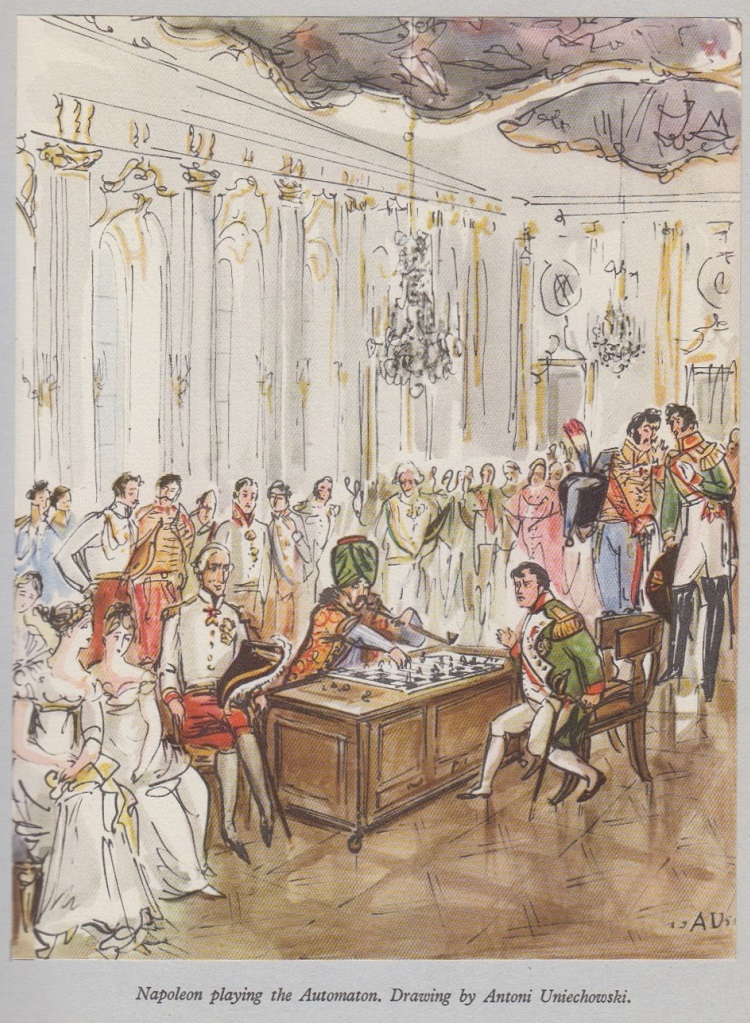
In the original edition, Z szachami przez wieki i kraje (Warsaw, 1960), the picture is opposite page 116.
A cartoon based on the picture of Napoleon at the start of the present article can be found in Η ζωή μας είναι σκάκι by Κώστα Νιάρχου/Costas Niarchos (Athens, 1972).
An item on pages 178-179 of A Chess Omnibus noted that C.J.S. Purdy attempted to make light of Hitler in a satirical one-act play ‘Hell Hitler’ in “Among These Mates” (Sydney, 1939), a book which he published under the pseudonym Chielamangus. The dramatis personae were Shade of Napoleon, Shade of Hitler, and Satan, and the play was founded on a spoof Hitler v Napoleon game: 1 e4 e5 2 Bc4 Bc5 3 Nf3 d6 4 d3 Be6 5 Bxe6 fxe6 6 Be3 Nd7 7 Bxc5 dxc5 8 Nbd2 Ne7 9 O-O O-O 10 Nc4 Ng6 11 c3 Qf6 12 Qb3 Nf4 13 Ne1 Qg5 14 Kh1 Rf6 15 Qxb7 Raf8 16 Qxc7 R8f7 17 Rg1 Qh4 18 Qc8+ Nf8 19 Ne3 Qxh2+ 20 Kxh2 Rh6+ 21 Kg3 Ne2+ 22 Kg4 Rf4+ 23 Kg5 Rh2 24 Qxf8+ Kxf8 25 Nf3 Kg8 26 Nxh2 h6+ 27 Kg6 Rf5 28 exf5 Nf4 mate.
This score was based on the famous brilliancy F. Herrmann v H. Hussong, Frankfurt, 1930 published on pages 314-315 of the October 1930 Deutsche Schachzeitung, October 1930, and, with Alekhine’s notes taken from Denken und Raten, on pages 340-342 of the December 1930 issue of Kagans Neueste Schachnachrichten:
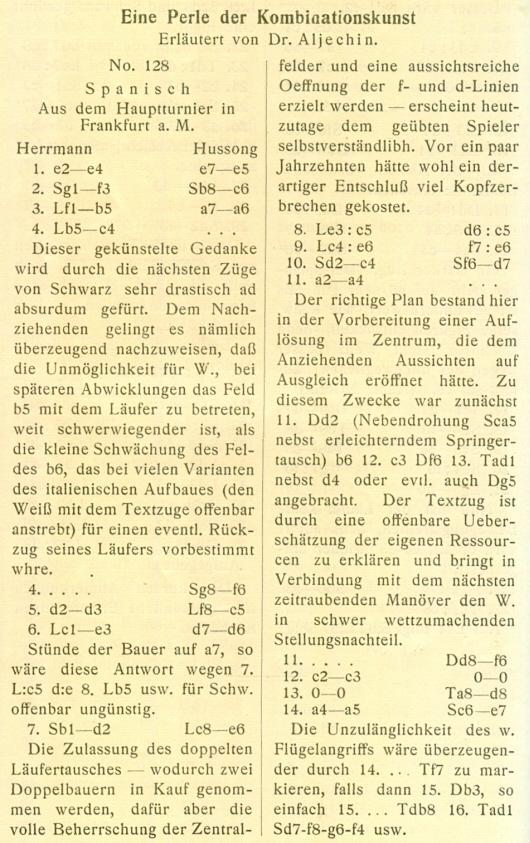
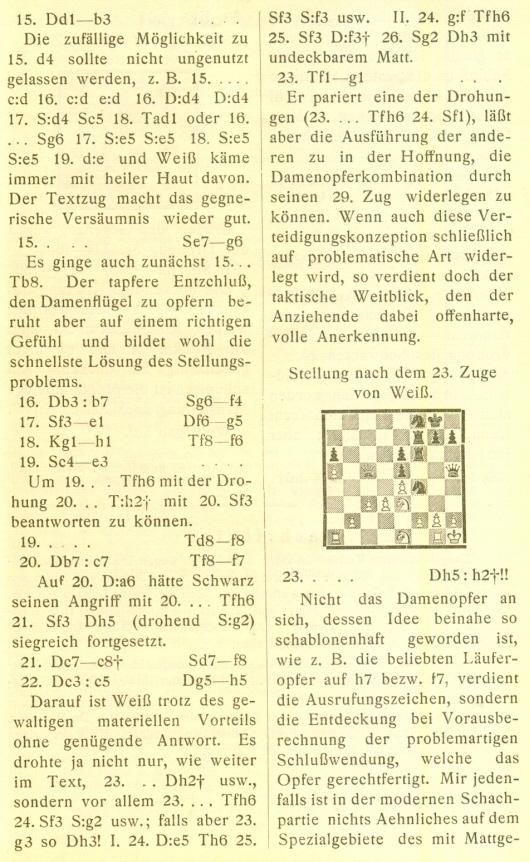
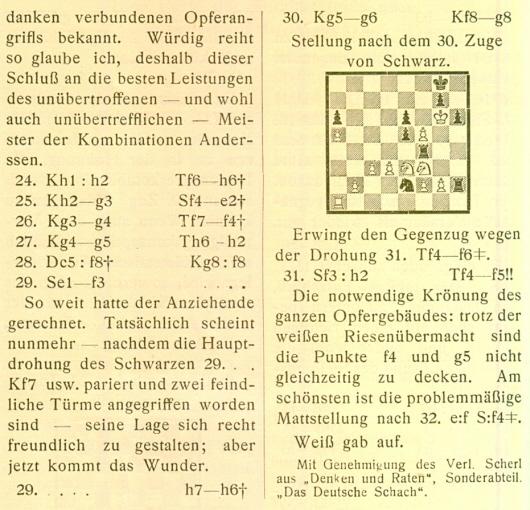
Below, from Purdy’s book, is the illustration on page 6 and the conclusion of the play on page 11:
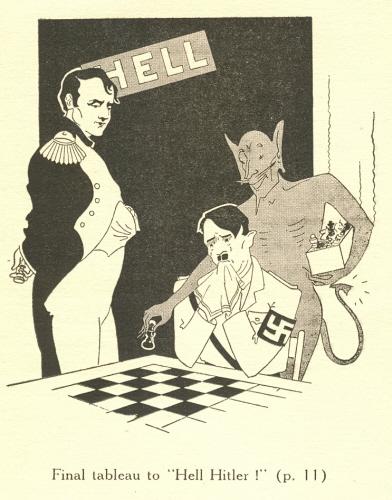
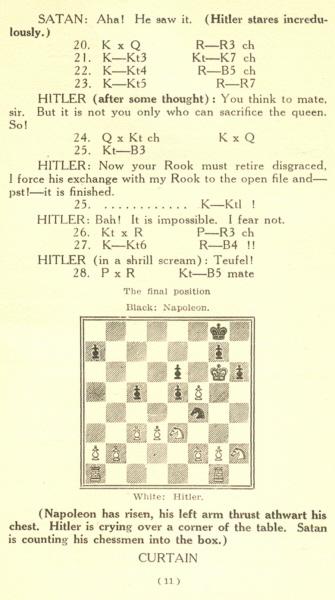
In conclusion, we add the following from page 8 of the October 1944 Chess Review:
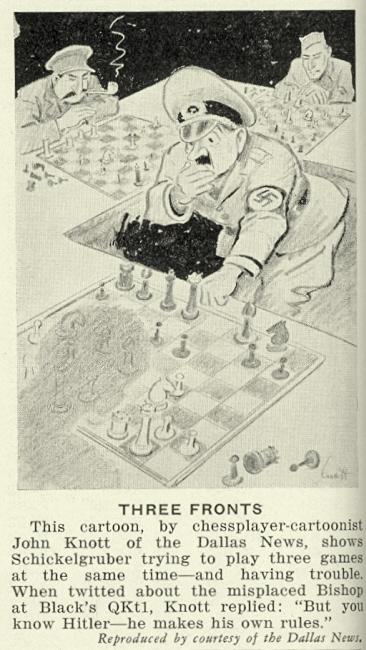
(7402)
Page 293 of the Complete Book of Beginning Chess by Raymond Keene (New York, 2003) has this untrue statement:
‘Similarly, we can still follow the moves of the one genuine game of chess played by Napoleon Bonaparte that has come down to posterity.’
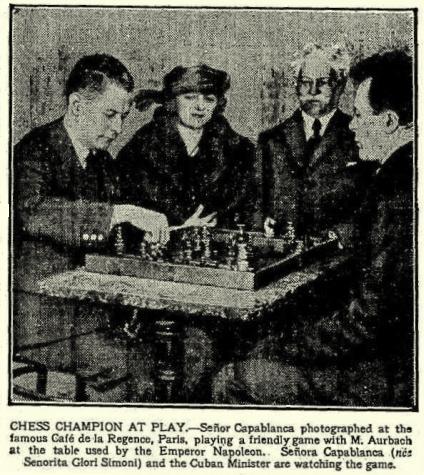
The Times, 30 March 1922, page 16
The request in C.N. 6481 for a better copy of this photograph has been answered by Eduardo Bauzá Mercére (New York, NY, USA). It comes from page 6 of the picture section of the New York Times, 30 April 1922:
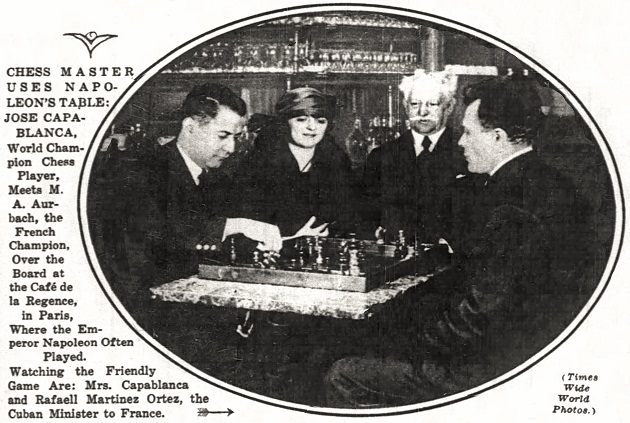
(11081)
Regarding Capablanca, Napoleon’s chess table and the Café de la Régence, see too C.N.s 4257, 8178, 8182 and 11081.
‘Chess is too much of a game to be a science and too much of a science to be a game’ is a remark sometimes ascribed, with variants, to Montaigne, Gottfried Leibniz and ‘Mendelssohn’, and it has been discussed in C.N.s 3574, 3676, 4133, 4378 and 8824.
Olimpiu G. Urcan has noted this version:
‘I abstain from chess – it’s too amusing to be fair work, and too hard work to be amusing.’
As readily verifiable on Google Books, those words were written by Thomas Henry Huxley in a letter dated 1 November 1866 to Alfred Russel Wallace.
An item about Napoleon Bonaparte on page 7 of King, Queen and Knight by N. Knight and W. Guy (London, 1975):

The text attributed to Napoleon in a 1961 Swedish translation of a book by Jerzy Giżycki (not ‘Gizyeki’) is, verbatim, what appears on page 213 of the 1972 English edition, entitled A History of Chess:
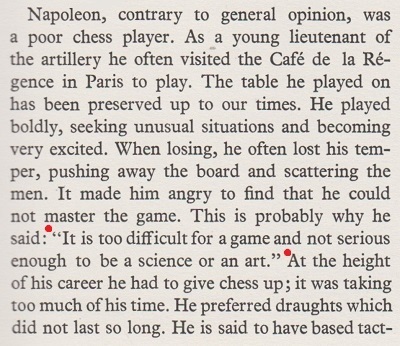
It is unclear why Knight and Guy referred to the Swedish edition, Stora Schackboken (Cracow, 1961), but, for the record, below is the relevant passage, from page 222:
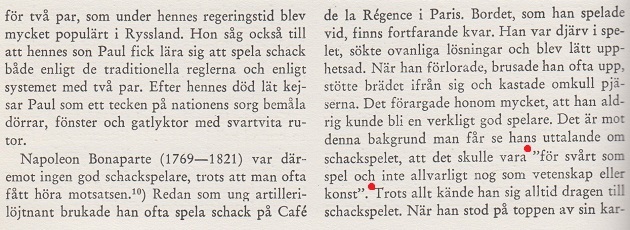
The original Polish book, Z szachami przez wieki i kraje, had been published in Warsaw in 1960 (and not 1961, as stated by Knight and Guy). An extract from page 184:
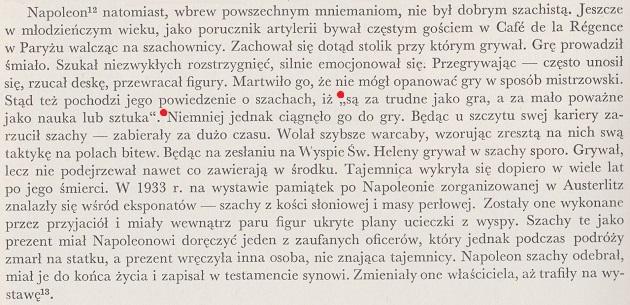
The corresponding endnotes on page 322:
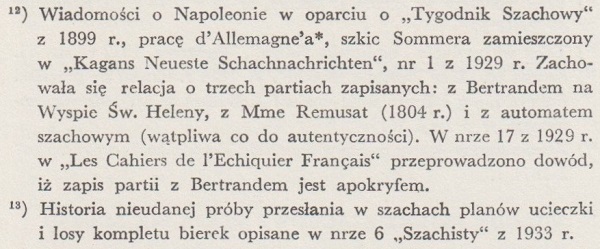
What are the exact grounds for attributing any such remark to Napoleon Bonaparte?
Wanted: information about this composition, ascribed to Napoleon on page 11 of the St Louis Daily Globe-Democrat, 29 October 1887:
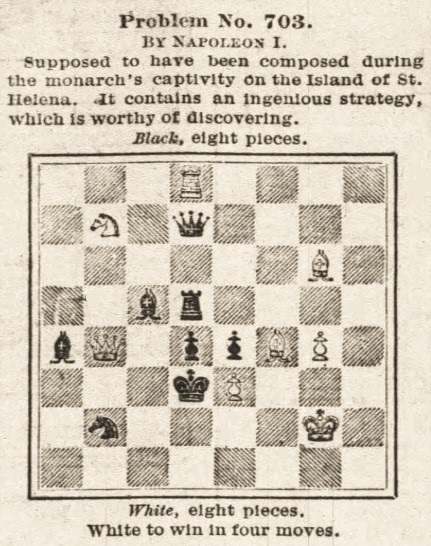
The (simple) solution was published on page 11 of the 19 November 1887 edition.
(11463)
Napoleon was discussed at the end of an article by James Mortimer entitled ‘How to Win at Chess’ on page 9 of the Daily Mail, 6 October 1906:
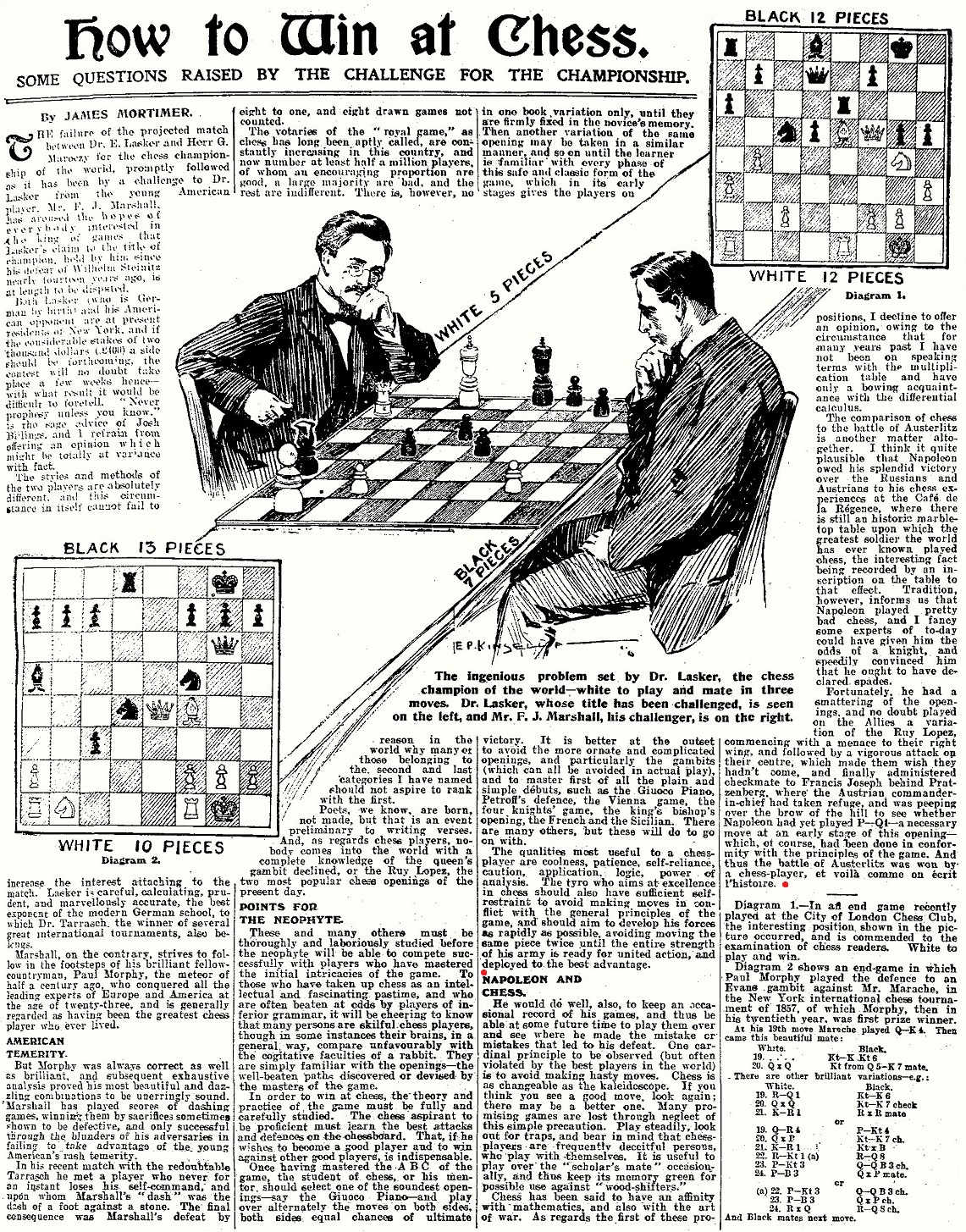
Addition on 23 May 2025:
From the Illustrated London News column, 30 November 1844, page 352 (mentioned above by H.J.R. Murray):

Concerning Napoleon III, see our feature article on Zukertort.
To the Chess Notes main page.
To the Archives for other feature articles.
Copyright: Edward Winter. All rights reserved.